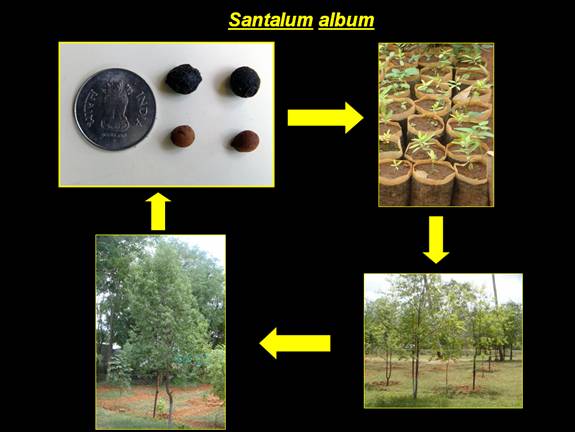SANDAL WOOD

Scientific name: Santalum album
Distribution – Indigenous to Peninsular India from Nasik and Southern towards tracts of parts of Mysore and Coorg and certain districts of Tamil Nadu. In Bombay the chief sandal region lies in the Dharwar and N. Kahara district along Mysore border. Occurs mainly in open jungle, hedge rows, lantana bushes, bamboo clumps and round the edges of cultivated lands. Javadi and Nilagiris (Salem and nearest districts) – 2000 to 4000 m and occasionally down to 1200 m above msl.
Climate – Rainfall in the chief sandal tracts varies between 625 mm to 1625 mm. Temperature 19°C to 28.5°C.
Soil: Flourishes best generally on red ferrugineous loam of the underlying rock being often metamorphic, chiefly gneiss. Found also on rocky ground stony or gravelly soil. Is not exacting as to depth of soil. Grows best on moist fertile alluvium along banks of stream. Those grown on proper soils are said to form more scented heartwood. Requires good drainage and does not stand water logging. Avoids saline and calcareous soil and is not generally found on black cotton soil.
Coppice – Young trees coppice well. Older trees are stated not to coppice at all except on ground along the banks of water courses.
Root sucker – Freely produces when roots are exposed or cut through or where parent tree has been grubbed up.
Germination – Viability (i.e., seed fertility) is 25 to 40% upto one year – seeds of 28 months gave 6% success. Depulped seeds give better germination per cent. Rats eat away the seeds and so it is usual to roll the seeds in main red lead or in Acorus paste. Germination takes place 1 to 3 months after sowing.
Artificial regeneration – Numerous plantations dating from 1870 have been found in Mysore, Coorg, North Coimbatore and Nilgiris, partly transplanting and partly by dibbling or sowing in situ. In the majority of cases they failed. One of the chief causes of failure was the incomplete realization of the parasitic nature of sandal. Another reason was the non-availability of shade in the early period, the sowing having been done in the open. Again wrong tending, as by sudden reveal of the lateral covering, which, in the case of young trees, accustomed to lateral shade, results in bark scorching. It commences with cracking and peeling of the bark in thin strips and later develops in long, more or less triangular, blisters. In bad cases wood is exposed considerably and death may result.
Artificial regeneration may be brought about by
1. Sowing in beds and planting out when 2 or 3 month old. Plant them when 10 cm or 12.5 cm high and have a taproot 15 cm to 20 cm long. Another way is to grow plants in a nursery and plant them out after a year.
2. Stump planting up to 3 years – 2¼ to 3 years old Sandal stumps are better than younger ones from the point of view of storage. Stumps stored in tins with tight lids have sprouted even when stored upto 20 days. Stump – planting has shown as much as 99% success
3. Planting pieces of roots
4. Root suckers
Hosts are suspected to be highly influential in conferring relative resistance, against spike. E.g., Strychnos nuxvomica, Pongamia glabra, Azadirachta indica and Cassia siamea are stated to give high resistance. Lantana is good but is suspected to harbour an insect vector.
Tending in earlier stages
1) Maintenance of good host plants and their tending
2) Provision for free and natural expansion of the crown
3) Felling of suppressed plants
4) Providing light lateral shade to avoid sun-scorch with free overhead light
In the later stages
1) Tending of hosts and
2) Climber cutting
Plant protection:
Drought – Capable of withstanding moderate drought, but prolonged drought kills it.
Fire – Extremely fire tender and may be killed outright or injured and rendered unsound.
Grazing and browsing – Moderate grazing does not seem to have any adverse effect. Grazing is infact intimately connected with its occurrence to keep out fires by keeping the grass low. It is readily browsed by cattle and deer and rabbit particularly in the dry season when grass is scarce and this constitutes the real danger to which it is subjected.
Injury by man – Being very much prized for its scented wood, it is always subject to heavy illicit felling.
Insects – The possible danger to the species is from some of the forest insects which are vectors of spike disease.
Spike disease – This disease is responsible for very serious loss year after year as it ultimately kills the trees in all the stages. It is caused by a virus carried from tree to tree by perhaps some forest insects. Experiments to isolate the insects concerned and to prevent infection are in progress. The insect is believed to be of the family – cossidae.
System of management – Generally coppice or coppice with standards and selection fellings.
Economic uses – Valued for its heartwood which is strongly scented. The wood is used for carving and fancy work. Oil distilled and used in perfumery and medicines for which it is the most valuable wood in India.
|

